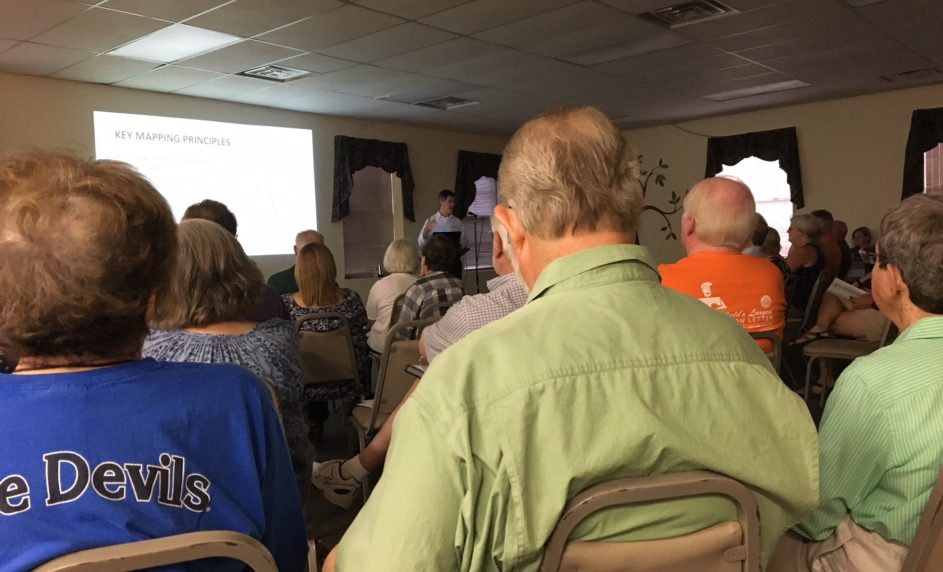Early chants of kumbaya died down, and pitchforks and torches began to appear as unanswered questions smoldered among the crowd of 80 on Thursday as MPC officials presented the (city only) Recode Knoxville zoning map in Fountain City.
Q&A: Attendees asked a number of questions about the various zones and their implications during the second hour of the meeting (after various public officials had departed). The main focus was on the labeling of individual lots and, more-heatedly, on how the new regs would affect neighborhoods.
For example, in trying to eliminate non-conforming undersized lots, the draft reduces the traditional, minimum 7,500 square feet building lot size to 5,000 square feet. Indirectly, this can foster increased potential to subdivide larger lots and double build on the smaller lots. What will keep the hungry developers at bay?
Others spoke of a recent nightmare by a developer who added 135 taller units on a large, steep lot in their single-family neighborhood. They first learned of this when the bulldozers started pushed down trees next door. Why weren’t they told in advance?
Larry Dearing of Adair Gardens raised the concern that Accessory Dwelling Units (ADU) could be built on every lot in the city. As one gentleman exclaimed, “We like our neighborhoods. Why can’t you just leave them alone?”
Former city council member Carlene Malone noted that ADUs can even be built on absentee-owned lots. And Jamie Rowe said her neighborhood is “excessively scared about all the potential ADUs. Nobody is exempt from this.” Is this part of city hall’s battle to curtail suburban development or to create higher-density, affordable housing? Might there be a less disruptive approach?
There were other questions about the proposed new laws, including the deletion or easing of standards for home daycare facilities, dog kennels and future zoning changes by city council.
Slide Show: The newly-issued zoning map, projected on the screen, assigns revised zoning names to each parcel out of the 73,000 parcels of land in Knoxville. Some 60,000 of those are residential uses. Tim Kuhn, MPC’s map specialist, explained the criteria used to create the proposed new map, demonstrated how to use online tools to navigate to specific parcels, and showed how to make one’s comments using the map’s online pop-up form. That presentation was followed by the open Q&A session. Traditional, written comments are also welcome.
MPC director Gerald Green explained that all comments (whether online or on paper) about the Aug. 6 proposed zoning map and the 200-page zoning text are due in two weeks, by Sept. 13.
Huh? Many folks only received a hard copy of the bound 200-page text at the door. And, they just learned how to use the online zoning map. As our two earlier Recode Knoxville articles make clear, that is a lot of technical information to digest. Recode would completely replace Knoxville’s existing zoning code.
Overall Schedule. MPC’s Green explained how the whirlwind schedule for Recode works. A final zoning text and edited zoning map are expected to be released in mid-October, and then placed on the MPC’s Nov. 8 agenda. That leaves only a 2- or 3-week interval for any additional citizen comments before MPC acts. If approved there — hold onto your seats! —it would reach the city council hearing a required 30 days later, in early December.
After repeated requests for more time to do their due diligence review, it became clear that city hall, not MPC, is controlling the end target; the other deadlines are thereby mathematically pre-determined. MPC is just the messenger. Citizens were told to contact the mayor and the council members for a reasonable review period.
Wait a minute! The existing zoning laws have been on the books for 50 years (obviously with many changes along the way). Nothing substantive compels the stated December target. Is it fear of the upcoming mayoral election? Private, unstated goals? That answer lies deep in the bowels or high on the sixth floor of the City County Building.
What do the citizens want? Doesn’t government represent the people? More time and focus are needed.

